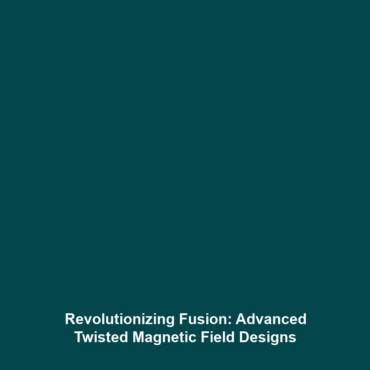Overview: Twisted Magnetic Field Design for Fusion Energy
Introduction
In the quest for sustainable and nearly limitless energy sources, fusion energy stands out as a key solution. This innovative field is continuously evolving, particularly with advancements in magnetic confinement systems. Twisted magnetic field designs offer a newer approach that resembles a tokamak but enhances confinement without relying on induced plasma current. This has potential implications for the efficiency and safety of fusion reactors, making it a significant focus in the future of energy technology.
Key Concepts
Understanding Twisted Magnetic Fields
The concept of utilizing a twisted magnetic field for plasma confinement draws from principles of electromagnetism and magnetohydrodynamics. In contrast to traditional tokamaks, which depend on induced currents to maintain plasma stability, these advanced designs employ a more complex configuration that enhances stability and reduces turbulence.
Integration with Fusion Energy
This design paradigm falls under the broader category of fusion energy, which aims to replicate the sun’s energy production process. By applying twisted magnetic fields, researchers aim to significantly improve the performance metrics of fusion reactors, including energy yield and operational lifetime.
Applications and Real-World Uses
The innovative twisted magnetic field design is expected to influence various sectors of research and practical applications. Here are some notable uses:
- Enhanced plasma confinement in fusion reactors, increasing energy output efficiency.
- Potential applications in international fusion projects, like ITER, aiming to validate plasma confinement methods.
- Research advancements that could benefit other fields, such as space propulsion technology.
Current Challenges
Despite its promise, the challenges of twisted magnetic field designs in fusion energy are significant:
- Complexity of technology integration into existing fusion reactors.
- High costs of developing and maintaining advanced magnetic systems.
- Need for further empirical data to validate design efficacy.
- Technical limitations in scaling the technology for practical use.
Future Research and Innovations
Looking ahead, several exciting innovations are on the horizon for twisted magnetic field designs in fusion energy:
- Research focused on optimizing magnetic field configurations for improved plasma stability.
- The development of next-generation materials that can withstand extreme conditions within reactors.
- Collaborations between international research institutions to accelerate technological advancements.
Conclusion
The twisted magnetic field design, analogous to traditional tokamak systems, presents a promising advancement within the fusion energy sector. With its potential to enhance plasma confinement while reducing reliance on induced currents, this technology could be pivotal for the future of sustainable energy. For further reading on related topics, explore our articles on Tokamak Analysis and Future Innovations in Fusion Energy.
